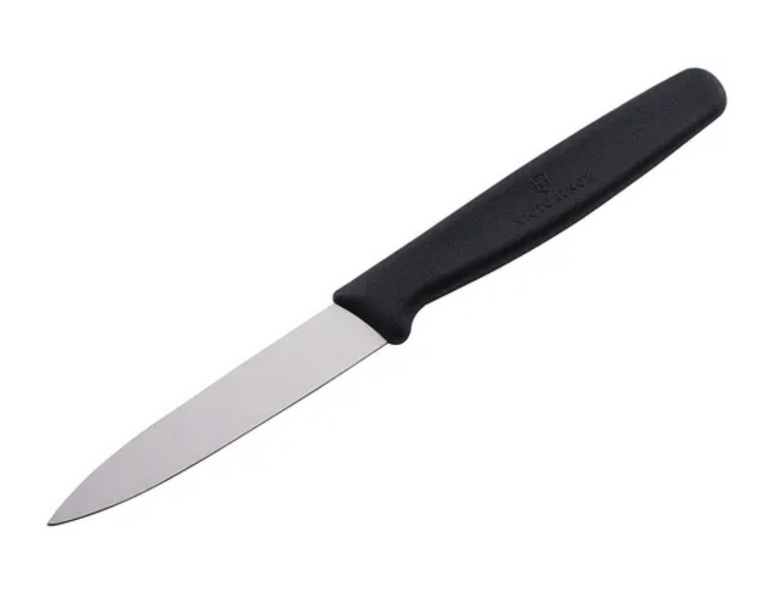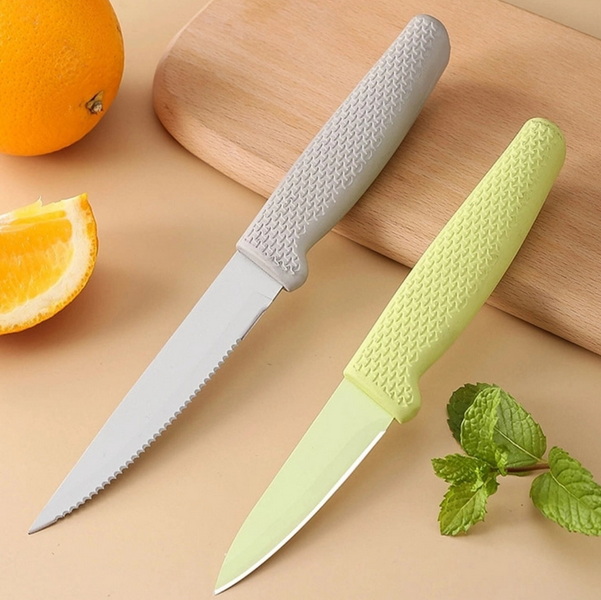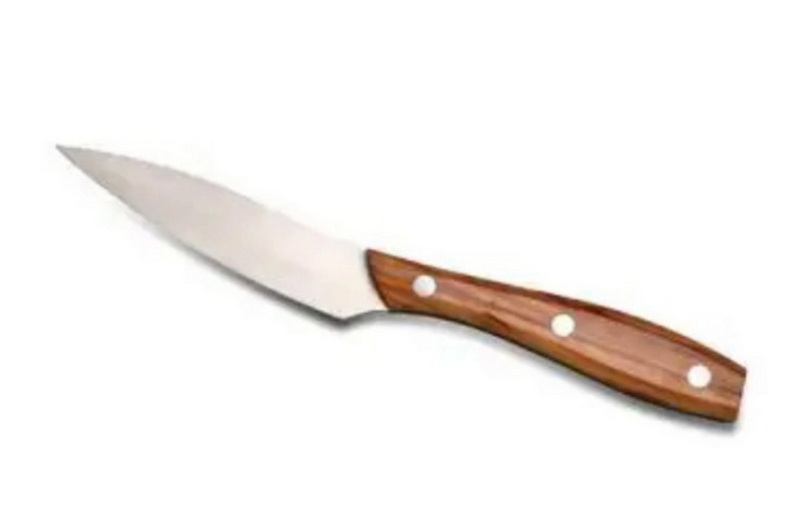- All
- Product Name
- Product Keyword
- Product Model
- Product Summary
- Product Description
- Multi Field Search
Views: 222 Author: Ann Publish Time: 2025-10-26 Origin: Site











Content Menu
● Overview of Paring Knife Excellence
● Materials and Blade Technology
● Handle ergonomics and construction
● Design and customization options
● Manufacturing and Quality Control
● ODM and OEM collaboration advantages
● Case for Paring Knife-Centric Lines
● A deeper look at blade geometry and edge preparation
● Handling and user experience
● Packaging, gifting, and value adds
● Quality assurance milestones for ODM/OEM paring knives
● Target markets and regional considerations
● How to initiate a successful OEM/ODM paring knife project
● Quality-focused collaboration workflow
● Regional regulatory and certification awareness
● Sustainability and responsible manufacturing
● Customer success stories and media-ready assets
● FAQ
>> 1) What materials are available for paring knife blades?
>> 2) Can you customize handle materials and branding?
>> 3) What is the typical lead time for an ODM paring knife project?
>> 4) How do you ensure quality across large production runs?
>> 5) Do you assist with packaging and marketing materials?
In today's competitive kitchenware market, OEM and ODM partnerships are built on trust, consistency, and the ability to customize without compromising quality. Our Chinese kitchen knife factory specializes in OEM services for foreign brands, wholesalers, and manufacturers, with a strong focus on paring knives. We deliver tailored solutions that meet exact specifications, from material selection and blade geometry to handle design and packaging. This article explains why OEM and ODM clients choose our paring knives, highlights key features, and provides practical guidance for collaboration.

A paring knife is the precision tool for delicate tasks such as peeling, trimming, and detailed work. The best paring knives combine a sharp, durable blade with an ergonomic handle and reliable balance. Our paring knives are designed to perform consistently across high-volume production while supporting customization for private-label brands. Whether you are building a premium line or a value-focused range, our ability to scale manufacturing, control quality, and tailor every component makes us a preferred partner for OEM and ODM projects.
- Stain-resistant stainless steel blades: We offer blades crafted from high-quality stainless steel alloys with excellent corrosion resistance and edge retention. The blade geometry is optimized for precision control in fine slicing and paring tasks.
- Carbon steel options: For brands seeking traditional performance, we provide carbon steel blades that take and hold an ultra-sharp edge, complemented by proper heat treatment to reduce chipping.
- Damascus-inspired patterns: For premium lines, we can produce paring knives with decorative Damascus patterns, marrying beauty with practical cutting performance.
- Edge retention and durability: Our heat-treating processes are tuned to balance hardness and durability, ensuring long-lasting sharpness in demanding kitchen environments.
- Ergonomic handles: We design handles that fit naturally in the hand, reducing fatigue during extended prep sessions. Materials range from high-strength plastics to full-traction composites and wood accents for premium lines.
- Full tang and secure assemblies: Our construction emphasizes durability and safety, with trusted tang designs and riveted or epoxy-secured scales depending on the target price point.
- Aesthetics and branding: We offer customization options such as logo engraving, colorways, and branding on the blade spine, handle scale, or end cap to align with customer brand identities.
- Blade profile and tip geometry: Clients can choose blade thickness, tip shape, and bevel angle to suit specific culinary tasks.
- Blade finish: Options include polished, satin, or matte finishes to achieve the desired look and performance.
- Packaging and presentation: Customized packaging, inserts, and displays enhance retailer appeal and help tell the brand story.
- Private labeling: We accommodate label placement, certificates, and packaging inserts to support market-specific requirements.
- Tooling and production scale: We have established tooling setups to efficiently produce large volumes of paring knives while maintaining tight tolerances.
- Quality assurance: Our QA processes cover blade hardness verification, edge sharpness testing, corrosion resistance checks, and handle integrity inspections.
- Compliance and safety: We adhere to international safety and labeling standards, ensuring that products meet the regulatory requirements of target markets.
- Fast onboarding: Our production teams understand the needs of foreign brands and can translate design intent into manufacturable specifications quickly.
- Cost optimization: We leverage economies of scale while offering value-added options such as customized blade finishes and packaging.
- Supply chain reliability: We maintain robust supplier networks for steels, handle materials, packaging, and logistics to minimize disruptions.
- Intellectual property protection: We provide confidentiality agreements and secure design handoffs to safeguard client IP.
- Precision-focused product lines: For brands emphasizing precise prep work, paring knives from our factory deliver consistent performance across batches.
- Educational and culinary media: Our paring knives pair well with recipe demonstrations, cooking workshops, and instructional content, supporting the marketing and storytelling needs of OEM partners.
- Cookbook and influencer collaborations: We can align with partners who want co-branded culinary tools aligned with culinary campaigns.

- Blade thickness and geometry: Our paring knives can be configured with thin blades for ultra-precise tasks or slightly thicker profiles for enhanced durability in tough tasks, with bevels tuned for left- or right-handed use as required.
- Edge sharpening processes: We employ multiple sharpening stages, from rough to fine, to achieve consistent burr-free edges. Our finishing steps include hand-honed micro-bevels for improved initial sharpness.
- Surface treatments: Polished finishes reduce food adhesion on the blade, while satin or matte finishes can minimize glare in professional kitchens.
- Corrosion resistance strategies: In addition to stainless steel selection, we apply protective coatings or passivation steps to extend service life in humid or saline environments.
- Balance and weight: Our ergonomic testing ensures optimal balance for controlled cuts with minimal wrist strain, which is critical for long prep sessions.
- Handle textures: Textured, non-slip scales improve grip when hands are wet or oily, enhancing safety and precision.
- Knife care compatibility: Our blades are designed to tolerate standard cleaning routines in professional kitchens, while offering guidance for home users on maintaining performance.
- Gift-ready packaging: Premium packaging options with branding, inserts, and care tips enhance perceived value.
- Care and maintenance inserts: Education on sharpening, cleaning, and storage supports customer satisfaction and reduces return risk.
- Sustainability: We offer eco-friendly packaging materials and design accommodations to meet brand sustainability goals.
- Pre-production samples: Hand-fitted samples for fit, finish, and balance approval.
- Pilot production: Small-batch runs to validate tooling, processes, and QA checks.
- Full production: Large-scale manufacturing with ongoing sampling and QA audits.
- Post-production support: Documentation, certifications, and replacement part availability.
- North America and Europe: Demand for high-precision paring knives with strong branding and packaging.
- Asia-Pacific: Growing interest in both budget-friendly and premium lines with reliable supply.
- Key requirements: Consistent edge quality, safe handling, and clear labeling for culinary education segments.
- Define core requirements: Material, blade geometry, handle material, finish, and packaging.
- Establish branding guidelines: Logo usage, color palette, typography, and product naming.
- Set QA expectations: Tolerances, testing protocols, and acceptance criteria.
- Plan logistics: Lead times, minimum order quantities, and shipping arrangements.
- Protect IP: Use non-disclosure agreements and document control procedures.
- Design-to-production handoff: Clear CAD data, material specifications, and process sheets ensure machinists can reproduce exact intent.
- Prototype testing: Functional testing in real kitchen scenarios to validate performance, ergonomics, and safety.
- Documentation export: Comprehensive BOMs, QA checklists, and packaging specs accompany every release.
- Continuous improvement: Post-launch feedback loops with joint marketing and product development reviews to refine offerings.
- Food-contact safety: All materials and finishes comply with relevant food-contact regulations to ensure consumer safety.
- Packaging compliance: Compliance with labeling and recycling requirements in target regions to support retailers and consumers.
- Import/export considerations: Documentation for duties, tariffs, and product classification to streamline cross-border sales.
- Material stewardship: Preference for recyclable materials and responsibly sourced woods or composites where applicable.
- Waste reduction: Efficient tooling and lean manufacturing practices minimize scrap.
- Lifecycle thinking: Consider repairability and spare-part availability to extend product life and reduce waste.
- Brand-building partnerships: We have collaborated with brand owners to create cohesive paring knife lines that align with brand stories and marketing campaigns.
- Educational content: Demonstrations and tutorials featuring our paring knives have been used by culinary schools and instructors to teach precise prep techniques.
- Influencer collaborations: Co-branded campaigns showcasing the performance and aesthetics of our paring knives.
Our paring knives exemplify how OEM and ODM collaboration can deliver tailored, high-quality products that align with brand strategy and market demands. By combining material excellence, ergonomic design, robust manufacturing, and comprehensive media support, we enable foreign brands to launch or expand successful paring knife lines with confidence.
We offer stain-resistant stainless steel, carbon steel, and decorative Damascus-inspired options, with various hardness levels and edge-retention characteristics.
Yes. We provide a range of handle materials, ergonomic designs, and branding opportunities including laser engraving and color customization.
Lead times vary by order size and customization; we can provide a production timeline after finalizing specifications during initial design reviews.
We implement strict QA processes, conduct hardness and sharpness tests, inspect finishes, and perform final approvals on pre-production and pilot batches.
Yes. We offer packaging design, inserts with care instructions, and media-ready product shots and videos to support marketing efforts.
The Ultimate Professional Knives for Halal Butchery in Middle Eastern Kitchens
Chef Knife Size Guide: Choosing Between 6″, 8″, 10″, And 12″
Custom Knife Handles: How To Design A Chef Knife That Fits Your Hand Perfectly
Chef Knife Surface Treatments Guide: From Polished Migaki To Damascus Patterns
Inside Our Professional Knife Sample Room: Quality You Can See
Universal Knife Block Buying Guide: Modern Acrylic & ABS Knife Holders for Professional Kitchens
Universal Knife Block: The Complete Guide To Modern, Hygienic Knife Storage
The Complete Guide To Red Handle Knife Sets: Style Meets Functionality in The Kitchen
Professional Knives for Halal Butchery And Middle Eastern Cuisine